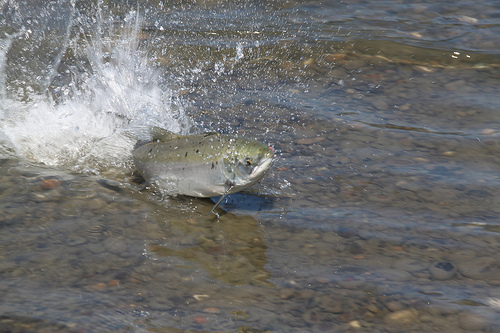By Sasha Moedt (The Cascade) – Email
Print Edition: November 9, 2011
The inquiry looking into the decline of the sockeye salmon of BC’s coast, the Cohen Commission, is focusing on the recent verification that infectious salmon anemia (ISA) is indeed in our water. ISA, a disease that has wiped out fish stocks in Norway and Chile, was found in the Fraser River.
The discovery is a heavy blow environmentally, as the disease was discovered in the wild salmon, and is also a huge threat to the salmon farming industry.
Biologist Alexandra Morton points to the introduction of the disease by imported salmon eggs – namely, fish farms. Morton says she is “on a steep learning curve” in her recent blog entry.
“It is essential that we move forward to establish an international board to make sure testing is done in a highly and scientifically defensible manner, establish a BC lab that can culture and test for ISA virus and report publicly, test widely for the virus in the ocean, rivers and lakes and include other possible species such as herring, [as well as] mandate tests on every Atlantic salmon facility, especially the lake-rearing facilities by more than one lab so that no one lab bears the brunt of this and so the public can take full confidence in the test.”
Colleen Dane of the BC Salmon Farmers Association, on the other hand, said that they have “done in the past few years 5000 tests and we’ve never found ISA on our farms… we are looking at our samples and continuing monitoring protocols on our farms, and we’re continuing to not see the disease in our farmed fish. So what that news does is it raised a lot of questions… how long it’s been here, what effect it has on the salmon because not all strains of ISA are pathogenic, they don’t all cause disease that then kills the fish.”
Dane stressed the importance of care taken for farmed salmon, at the base level of farms and at industrial research levels, with immunizations and screenings.
Activists like Morton and salmon farmers clash constantly at the Cohen Commission. Issues of disease and viruses are consistently raised, but Dane responded to the lack of evidence. “ It’s important to consider, when you are talking about people who are criticising salmon farming, and raise disease, it’s important to consider what disease exactly they are talking about, and whether it’s actually here. Because there is quite a bit of consideration about what or what might happen but actually isn’t happening in British Columbia.”
The four independent experts hired for the Commission to look into the correlation between the decline and fish farms evidently found nothing. Morton condemns the “secrecy” in government research of the issues of disease. “There is an astonishing silence from government. How is it possible they have never found ISA virus?”
We need to look at our priorities, and our government’s. Are they trying to save an economically-profitable, environmentally-devastating industry by keeping quiet about research? Or are they avoiding looking into the issues altogether? This is, apparently, a democracy. We need open, direct information about this issue – public understanding, where all the information is available and clear. We don’t need the government to be cloak-and-daggering around with incompetent reports, muzzled scientists, and withdrawn research funds.
The impact of ISA on the marine environment is only just dawning on us. If wild salmon were to be wiped out like the farmed stocks in other countries, what would become of the wildlife that depends on the salmon for survival? The action of the Cohen Commission to look into the discovery of ISA in the Fraser River is somewhat reassuring, but with a government that has skewed priorities, who knows what’s coming.


